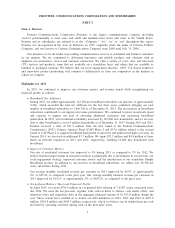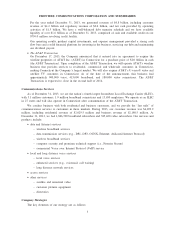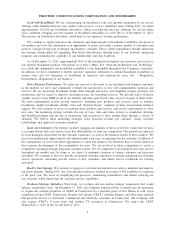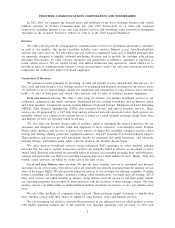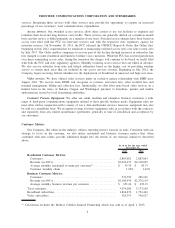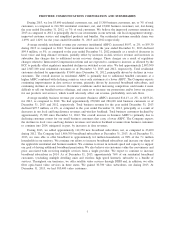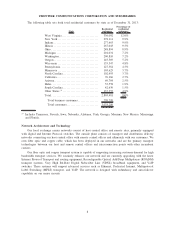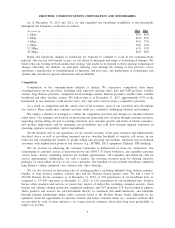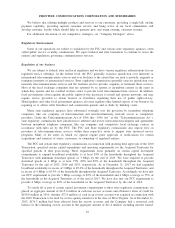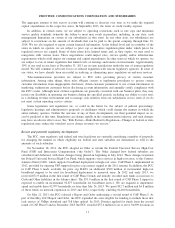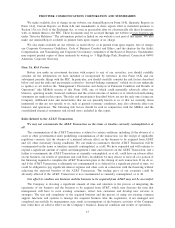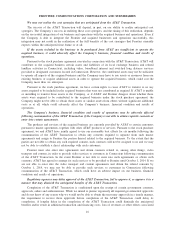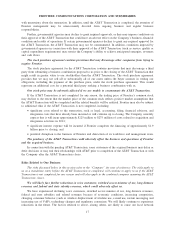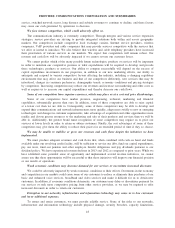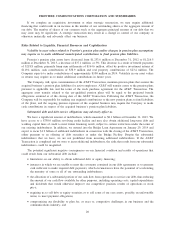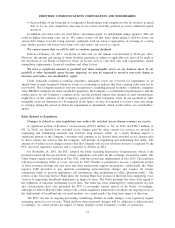Frontier Communications 2013 Annual Report Download - page 13
Download and view the complete annual report
Please find page 13 of the 2013 Frontier Communications annual report below. You can navigate through the pages in the report by either clicking on the pages listed below, or by using the keyword search tool below to find specific information within the annual report.our high-cost, unserved and underserved areas across multiple states. The FCC also announced on January 10,
2014, that Frontier was eligible for an additional $3.7 million in funding to serve 6,815 locations. The second
round of CAF Phase I includes certain accompanying spending requirements from the Company, and our
capital expenditure plans take this into account. The CAF funds received are accounted for as Contributions in
Aid of Construction and were initially recorded as increases to Cash and Other liabilities on the balance sheet.
The Order also reformed Intercarrier Compensation, which is the payment framework that governs how
carriers compensate each other for the exchange of interstate traffic, and it began a multi-year transition in July
2012, with the second step implemented in July 2013. The transition will move terminating traffic to a near
zero rate by 2017. Frontier expects to be able to recover a significant portion of those revenues through end
user rates and other replacement support mechanisms. The Order has been challenged by certain parties in court
and certain parties have also petitioned the FCC to reconsider various aspects of the Order. Accordingly, we
cannot predict the long-term impact at this time but believe that the Order will provide a stable regulatory
framework to facilitate our ongoing focus on the deployment of broadband into our rural markets.
Future reductions in our subsidy or switched access revenues may directly affect our profitability and cash
flows. Switched access and subsidy revenues continued to decline in 2013, as compared to 2012, and are
expected to decline further in 2014.
The FCC also has an ongoing proceeding considering whether to make changes to its regulatory regime
governing special access services, including whether to mandate lower rates, change standards for deregulation
and pricing flexibility, or to require changes to other terms and conditions. When and how these proposed
changes will be addressed is unknown and, accordingly, we are unable to predict the impact of future changes
on our results of operations.
Certain state regulatory commissions regulate some of the rates ILECs charge for intrastate services,
including rates for intrastate access services paid by providers of intrastate long distance services. The Order,
however, removes much of the states’ authority to set terminating intrastate switched access rates. This aspect
of the Order has been challenged by certain parties in court. Certain states also have their own open
proceedings to address reform to intrastate access charges and other intercarrier compensation and state
universal service funds. Although the FCC has pre-empted state jurisdiction on most access charges, many
states could consider moving forward with their proceedings. We cannot predict when or how these matters will
be decided or the effect on our subsidy or switched access revenues.
Regulators at both the federal and state levels continue to address whether VoIP services are subject to the
same or different regulatory and intercarrier compensation regimes as traditional voice telephony. The FCC has
concluded that VoIP and facilities-based broadband Internet access providers must comply with the
Communications Assistance for Law Enforcement Act, a decision that the United States Court of Appeals for
the District of Columbia Circuit has upheld. The FCC has also required VoIP providers to provide enhanced
911 emergency calling capabilities. In the Order, the FCC has determined that VoIP-originated traffic
terminating on the Public Switched Telephone Network is subject to interstate access rates. Additionally, the
Order requires VoIP providers to pay interstate terminating interconnection charges and requires all carriers
terminating traffic to provide appropriate call information, thus prohibiting so-called “phantom traffic.”
However, the FCC declined to address other VoIP-related issues, and the FCC has stated its intent to address
open questions regarding the treatment of VoIP services in its ongoing “IP-Enabled Services Proceeding.”
Internet telephony may have an advantage in the marketplace over our traditional services if this service
remains less regulated.
Current and potential Internet regulatory obligations
In connection with our Internet access offerings, we could become subject to laws and regulations as they
are adopted or applied to the Internet. There is currently only limited regulation applicable to these services.
The FCC has classified wireline broadband Internet access service (whether provided over cable or
telecommunications facilities), mobile wireless based broadband Internet access service and other forms of
broadband Internet access services as “information services” not subject to mandatory common carriage
regulation. Specifically, the FCC has determined that these information services are functionally integrated with
12
FRONTIER COMMUNICATIONS CORPORATION AND SUBSIDIARIES


